|
USS Hornet (CV-12/CVA-12/CVS-12) |
|
"The Grey Ghost" |
|
USS Hornet (CV-12/CVA-12/CVS-12), Essex-class fleet aircraft carrier, eighth United States ship to bear the name. She served in three wars and supported two Apollo moon landing missions between 1943 and 1970. Acquired by a private group of volunteers in 1995 and converted into a floating museum, Hornet now rests fitfully in the San Francisco Bay. Alameda Point is located on the grounds of the former Naval Air Station Alameda, California, on the east side of the Bay. Alameda itself is an island that sits just outside Oakland, California, and is at the geographical center of the San Francisco Bay. Until its closure in 1997, NAS Alameda, with its huge carrier berths, frequently played home to many of the Pacific Fleet's aircraft carriers.
Tied up at Pier 3, opposite the SS Cape Fear (T-AK-5061), is the Hornet. Visitor access to the ship is provided via a gangplank that leads to the main entrance area in Hangar Bay 1. The ship has been beautifully restored by museum volunteers, and many spaces on several different decks are now accessible to the curious. Most of the tours are self-guided, and
involve climbing up and down ladders and through hatches. People who
have not spent much time aboard Navy vessels should be careful to mind
their heads and shins when passing through hatches and stepping through
the "knee-knockers" that separate the compartments of the ship.
See more of the hangar
deck.
See more of the island: - Pri-Fly - Bridge and
pilothouse See more of the flight
deck.
The second deck is nearly entirely accessible to visitors and includes sickbay, the Marine quarters, air wing spaces and a number of large ready rooms, and the wardroom. Various spaces on other decks are also open, including the fo'c'sle, on the first deck forward of Hangar Bay 1. The propulsion spaces, located on and around deck five, is accessible via guided tour. Volunteer docents lead groups of fifteen people through the Marine quarters, the electrical shop, and down below into the engine room. See more of the interior decks: - Sickbay
|
| July 21, 2003 || Return to Vulture's Row || Return to Home Page || E-mail |
| Copyright © 2003 Robin J. Lee <robin.lee@aya.yale.edu>. All rights reserved. |
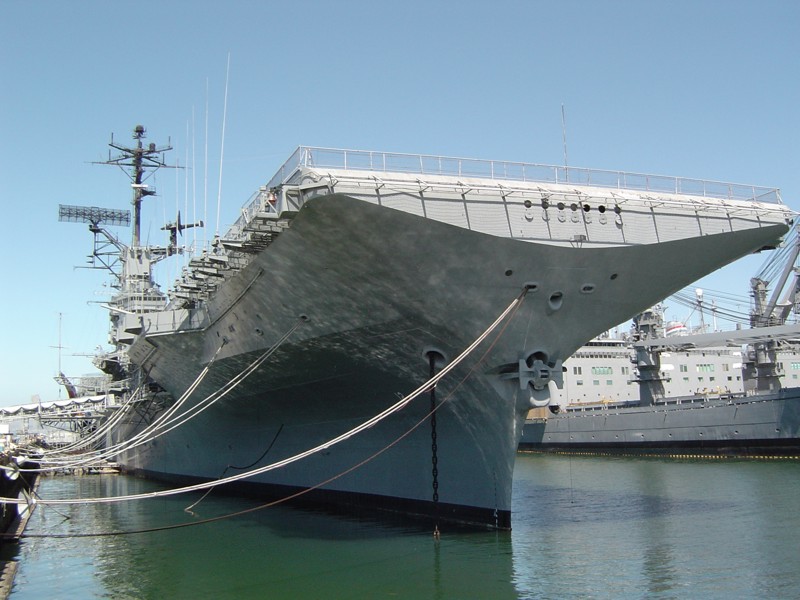
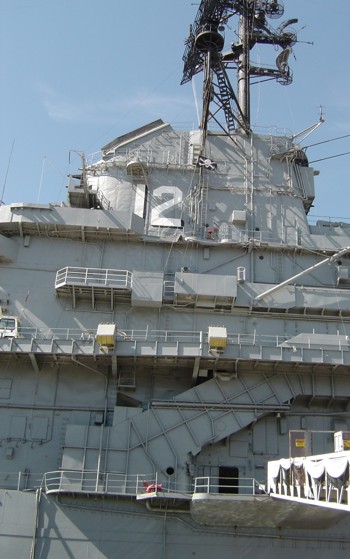 Emerging
from the Webster Street tube and turning west on Atlantic Avenue, you pass
through the old air station gate, now unmanned. Turn left on Ferry
Point Street, along the waterfront, and the piers will come into
view. The first ships that you probably will see are a number of
gray auxiliary ships with names like Admiral Wm. M. Callaghan, Cape
Orlando, and Comet. These merchant ships are part of the U.S. Ready Reserve Fleet, ready to be activated
for tasking by the Military Sealift Command on four days' notice. In fact, some
of the ships moored at Alameda were only recently deployed in support of
Operation Iraqi Freedom.
Emerging
from the Webster Street tube and turning west on Atlantic Avenue, you pass
through the old air station gate, now unmanned. Turn left on Ferry
Point Street, along the waterfront, and the piers will come into
view. The first ships that you probably will see are a number of
gray auxiliary ships with names like Admiral Wm. M. Callaghan, Cape
Orlando, and Comet. These merchant ships are part of the U.S. Ready Reserve Fleet, ready to be activated
for tasking by the Military Sealift Command on four days' notice. In fact, some
of the ships moored at Alameda were only recently deployed in support of
Operation Iraqi Freedom.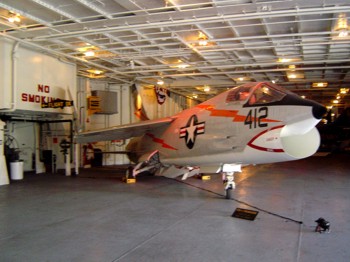 The
hangar deck's three bays host the orientation area, ship's store,
Apollo program exhibits, and departure points for the various ship
tours. There are also a number of static aircraft displays,
including an F8U-1/F-8A Crusader, a TA-4J Skyhawk, and, most recently, an F-14A Tomcat.
The
hangar deck's three bays host the orientation area, ship's store,
Apollo program exhibits, and departure points for the various ship
tours. There are also a number of static aircraft displays,
including an F8U-1/F-8A Crusader, a TA-4J Skyhawk, and, most recently, an F-14A Tomcat.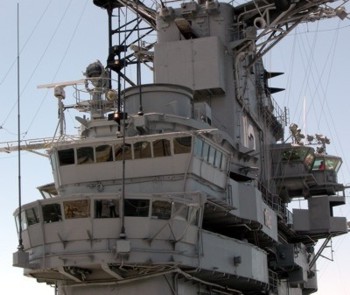 The
island is home to many of the critical operations spaces of the
ship, including the navigation bridge, pilothouse and auxiliary conn, and
primary flight control (Pri-Fly). Vulture's Row is also located on
the island, just below Pri-Fly.
The
island is home to many of the critical operations spaces of the
ship, including the navigation bridge, pilothouse and auxiliary conn, and
primary flight control (Pri-Fly). Vulture's Row is also located on
the island, just below Pri-Fly.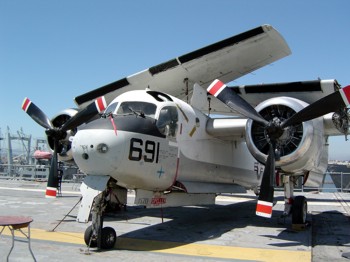 The flight
deck is located three decks above the hangar deck. Hornet's
two bow catapults, the landing area, and a gorgeous view of the San
Francisco Bay can be found here. There are also a number of static
aircraft displays, including this immaculately restored Grumman US-2B
Tracker.
The flight
deck is located three decks above the hangar deck. Hornet's
two bow catapults, the landing area, and a gorgeous view of the San
Francisco Bay can be found here. There are also a number of static
aircraft displays, including this immaculately restored Grumman US-2B
Tracker.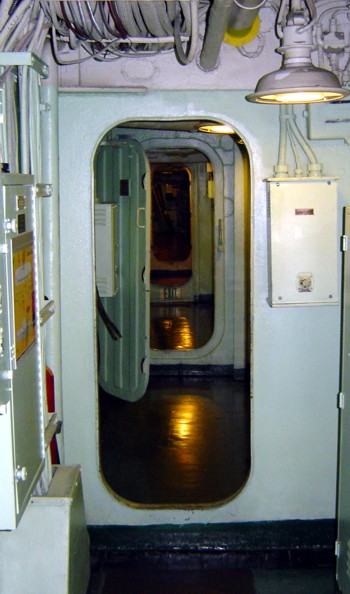 The
interior decks comprise all of the spaces below the flight
deck. Hornet's decks are numbered beginning with the hangar
deck (first deck), with numbers increasing as one proceeds below toward
the waterline. There are also two decks between the hangar deck and
the flight deck (O-1 and O-2). The interior decks are cool and
well-lit, and the odor of fresh paint pervades the passageways.
The
interior decks comprise all of the spaces below the flight
deck. Hornet's decks are numbered beginning with the hangar
deck (first deck), with numbers increasing as one proceeds below toward
the waterline. There are also two decks between the hangar deck and
the flight deck (O-1 and O-2). The interior decks are cool and
well-lit, and the odor of fresh paint pervades the passageways.